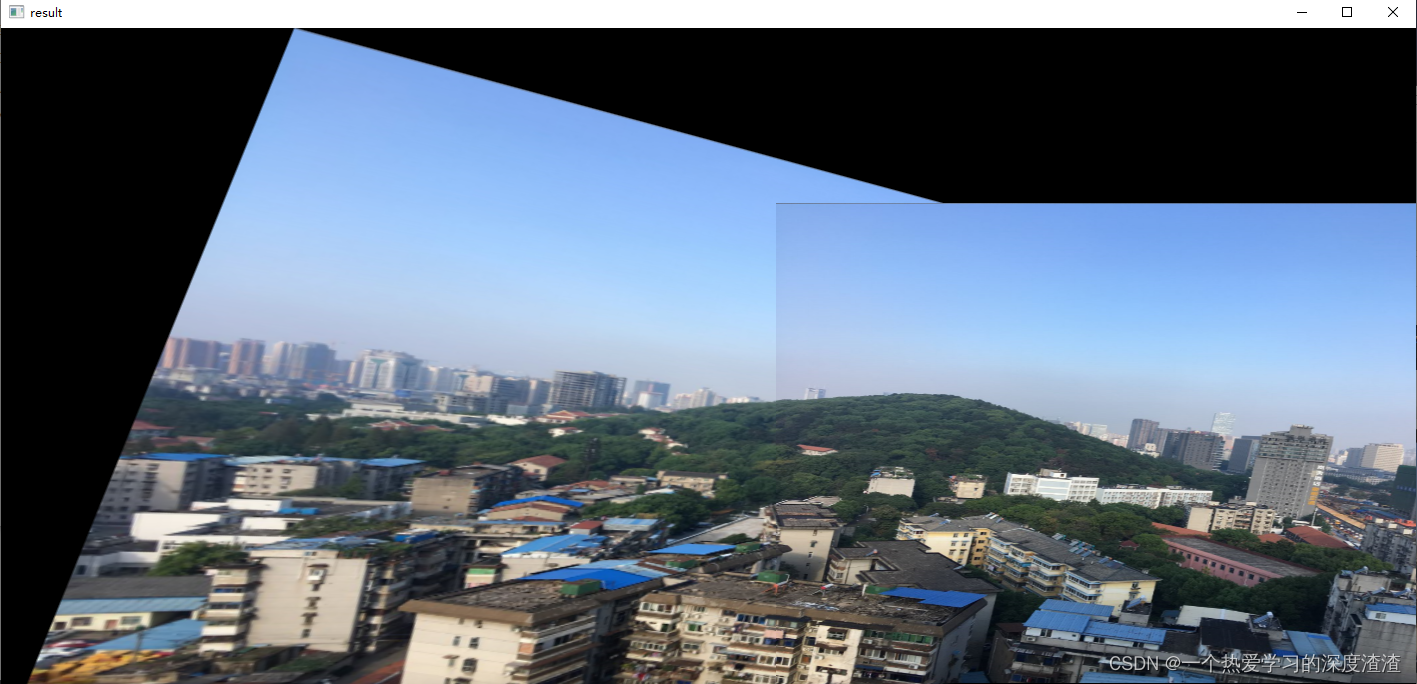热门标签
热门文章
- 1全国计算机OFFICE二级考试大纲,全国计算机等级考试二级MSOffice高级应用考试大纲...
- 2Java开发环境搭建(详细)
- 3我把Java基础编程及思维导图整理的超级详细,谁都能看懂_java思维导图笔记
- 4Keil uVision5 5.38官方下载、安装及注册教程_keil uvision5下载
- 5Python中八种基本排序方法_buchiyexiao
- 66种打包Python代码的方法,让你的程序变成exe应用!_python打包exe
- 7LAN技术 -- MAC地址表、端口安全_获取lan口mac地址
- 8《C语言程序设计》课程总结报告_pintia.cn
- 9python安装后怎么打开?这三种方法你一定要会_python怎么打开_python 打开
- 10Python 开机自启动_python autostart 设置开机自启
当前位置: article > 正文
【OpenCV学习】(十一)图像拼接实战_深度学习做图片拼接
作者:我家自动化 | 2024-02-14 20:12:26
赞
踩
深度学习做图片拼接
【OpenCV学习】(十一)图像拼接实战
背景
图像拼接可以应用到手机中的全景拍摄,也就是将多张图片根据关联信息拼成一张图片;
实现步骤
1、读文件并缩放图片大小;
2、根据特征点和计算描述子,得到单应性矩阵;
3、根据单应性矩阵对图像进行变换,然后平移;
4、图像拼接并输出拼接后结果图;
一、读取文件
第一步实现读取两张图片并缩放到相同尺寸;
代码如下:
img1 = cv2.imread('map1.png')
img2 = cv2.imread('map2.png')
img1 = cv2.resize(img1, (640, 480))
img2 = cv2.resize(img2, (640, 480))
input = np.hstack((img1, img2))
cv2.imshow('input', input)
cv2.waitKey(0)
- 1
- 2
- 3
- 4
- 5
- 6
- 7
- 8
- 9

上图为我们需要拼接的两张图的展示,可以看出其还具有一定的旋转变换,之后的图像转换必定包含旋转的操作;
二、单应性矩阵计算
主要分为以下几个步骤:
1、创建特征转换对象;
2、通过特征转换对象获得特征点和描述子;
3、创建特征匹配器;
4、进行特征匹配;
5、过滤特征,找出有效的特征匹配点;
6、单应性矩阵计算
实现代码:
def get_homo(img1, img2): # 1实现 sift = cv2.xfeatures2d.SIFT_create() # 2实现 k1, p1 = sift.detectAndCompute(img1, None) k2, p2 = sift.detectAndCompute(img2, None) # 3实现 bf = cv2.BFMatcher() # 4实现 matches = bf.knnMatch(p1, p2, k=2) # 5实现 good = [] for m1, m2 in matches: if m1.distance < 0.8 * m2.distance: good.append(m1) # 6实现 if len(good) > 8: img1_pts = [] img2_pts = [] for m in good: img1_pts.append(k1[m.queryIdx].pt) img2_pts.append(k2[m.trainIdx].pt) img1_pts = np.float32(img1_pts).reshape(-1, 1, 2) img2_pts = np.float32(img2_pts).reshape(-1, 1, 2) H, mask = cv2.findHomography(img1_pts, img2_pts, cv2.RANSAC, 5.0) return H else: print('piints is not enough 8!') exit()
- 1
- 2
- 3
- 4
- 5
- 6
- 7
- 8
- 9
- 10
- 11
- 12
- 13
- 14
- 15
- 16
- 17
- 18
- 19
- 20
- 21
- 22
- 23
- 24
- 25
- 26
- 27
- 28
- 29
三、图像拼接
实现步骤:
1、获得图像的四个角点;
2、根据单应性矩阵变换图片;
3、创建一张大图,拼接图像;
4、输出结果
实现代码:
def stitch_img(img1, img2, H): # 1实现 h1, w1 = img1.shape[:2] h2, w2 = img2.shape[:2] img1_point = np.float32([[0,0], [0,h1], [w1,h1], [w1,0]]).reshape(-1, 1, 2) img2_point = np.float32([[0,0], [0,h2], [w2,h2], [w2,0]]).reshape(-1, 1, 2) # 2实现 img1_trans = cv2.perspectiveTransform(img1_point, H) # 将img1变换后的角点与img2原来的角点做拼接 result_point = np.concatenate((img2_point, img1_trans), axis=0) # 获得拼接后图像x,y的最小值 [x_min, y_min] = np.int32(result_point.min(axis=0).ravel()-0.5) # 获得拼接后图像x,y的最大值 [x_max, y_max] = np.int32(result_point.max(axis=0).ravel()+0.5) # 平移距离 trans_dist = [-x_min, -y_min] # 构建一个齐次平移矩阵 trans_array = np.array([[1, 0, trans_dist[0]], [0, 1, trans_dist[1]], [0, 0, 1]]) # 平移和单应性变换 res_img = cv2.warpPerspective(img1, trans_array.dot(H), (x_max-x_min, y_max-y_min)) # 3实现 res_img[trans_dist[1]:trans_dist[1]+h2, trans_dist[0]:trans_dist[0]+w2] = img2 return res_img H = get_homo(img1, img2) res_img = stitch_img(img1, img2, H) # 4实现 cv2.imshow('result', res_img) cv2.waitKey(0)
- 1
- 2
- 3
- 4
- 5
- 6
- 7
- 8
- 9
- 10
- 11
- 12
- 13
- 14
- 15
- 16
- 17
- 18
- 19
- 20
- 21
- 22
- 23
- 24
- 25
- 26
- 27
- 28
- 29
- 30
- 31
- 32

最终结果图如上图所示,还有待优化点如下:
- 边缘部分有色差,可以根据取平均值消除;
- 黑色区域可进行裁剪并用对应颜色填充;
优化部分难度不大,有兴趣的可以实现一下;
总结
图像拼接作为一个实用性技术经常出现在我们的生活中,特别是全景拍摄以及图像内容拼接;当然,基于传统算法的图像拼接还是会有一些缺陷(速度和效果上),感兴趣的可以了解下基于深度学习的图像拼接算法,期待和大家沟通!
声明:本文内容由网友自发贡献,不代表【wpsshop博客】立场,版权归原作者所有,本站不承担相应法律责任。如您发现有侵权的内容,请联系我们。转载请注明出处:https://www.wpsshop.cn/w/我家自动化/article/detail/81290
推荐阅读
相关标签



